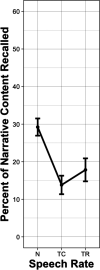Strategic Pauses Relieve Listeners from the Effort of Listening to Fast Speech: Data Limited and Resource Limited Processes in Narrative Recall by Adult Users of Cochlear Implants
- PMID: 37941344
- PMCID: PMC10637151
- DOI: 10.1177/23312165231203514
Strategic Pauses Relieve Listeners from the Effort of Listening to Fast Speech: Data Limited and Resource Limited Processes in Narrative Recall by Adult Users of Cochlear Implants
Abstract
Speech that has been artificially accelerated through time compression produces a notable deficit in recall of the speech content. This is especially so for adults with cochlear implants (CI). At the perceptual level, this deficit may be due to the sharply degraded CI signal, combined with the reduced richness of compressed speech. At the cognitive level, the rapidity of time-compressed speech can deprive the listener of the ordinarily available processing time present when speech is delivered at a normal speech rate. Two experiments are reported. Experiment 1 was conducted with 27 normal-hearing young adults as a proof-of-concept demonstration that restoring lost processing time by inserting silent pauses at linguistically salient points within a time-compressed narrative ("time-restoration") returns recall accuracy to a level approximating that for a normal speech rate. Noise vocoder conditions with 10 and 6 channels reduced the effectiveness of time-restoration. Pupil dilation indicated that additional effort was expended by participants while attempting to process the time-compressed narratives, with the effortful demand on resources reduced with time restoration. In Experiment 2, 15 adult CI users tested with the same (unvocoded) materials showed a similar pattern of behavioral and pupillary responses, but with the notable exception that meaningful recovery of recall accuracy with time-restoration was limited to a subgroup of CI users identified by better working memory spans, and better word and sentence recognition scores. Results are discussed in terms of sensory-cognitive interactions in data-limited and resource-limited processes among adult users of cochlear implants.
Keywords: cochlear implants; narrative recall; pupillometry; speech vocoding; time-compressed speech.
Conflict of interest statement
Declaration of Conflicting InterestsThe authors declared no potential conflicts of interest with respect to the research, authorship, and/or publication of this article.
Figures







References
-
- Amichetti N. M., Neukam J., Kinney A. J., Capach N., March S. U., Svirsky M. A., Wingfield A. (2021). Adults with cochlear implants can use prosody to determine the clausal structure of spoken sentences. Journal of the Acoustical Society of America, 150(6), 4325. 10.1121/10.0008899 - DOI - PMC - PubMed
-
- Anderson R. C., Freebody P. (1981). Vocabulary knowledge. Comprehension and Teaching: Research Reviews, 77–117.
-
- Aronson D., Markowitz M., Shapiro H. (1971). Perception and immediate recall of normal and compressed auditory sequences. Perception and Psychophysics, 9, 338–344. 10.3758/BF03208691 - DOI
Publication types
MeSH terms
Grants and funding
LinkOut - more resources
Full Text Sources
Medical

